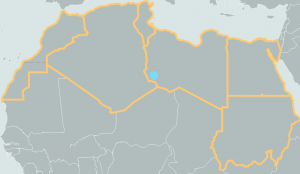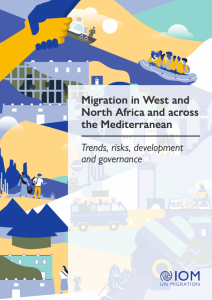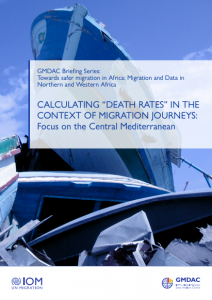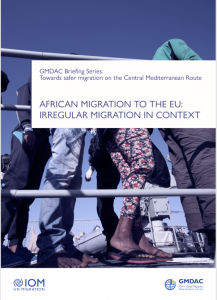
Migration data in Northern Africa
The six countries in Northern Africa1
– Algeria, Egypt, Libya, Morocco, Sudan and Tunisia – have historically been and remain significant countries of migrant destination, transit and departure. Economic, environmental and political instability contribute to the mixed migration patterns observed in the sub-region. Labour migration policies from as early as the 1950s incentivized mobility and played a role in the socioeconomic development of several Northern African countries (World Bank, 2010). Recent migration policies in the sub-region have affected human mobility trends, as well as migration route decisions.
At mid-year 2020, the sub-region hosted an estimated 3.2 million international migrants, nearly 61 per cent of whom were either from the same sub-region or other African sub-regions (UN DESA, 2020). An estimated 49 per cent of all international migrants in the region were refugees and asylum seekers. Globally, an estimated 12.3 million international migrants -- 4.4 per cent of the global migrant population -- were from Northern Africa. Of these emigrants, 48 per cent and 13 per cent were hosted in Europe and Western Asia respectively (ibid.).
- 1As defined by the UN Statistics Division
Recent trends
For an overview of migration data relevant to COVID-19 including data covering Northern Africa, visit the Portal's COVID-19 thematic page.
- HOST COUNTRIES: Sudan (1.4 million), Libya (826,537) and Egypt (543,937) were estimated to be the three countries hosting the highest number of international migrants in the sub-region at mid-year 2020 (UN DESA, 2020).
- DESTINATION COUNTRIES: The highest number of emigrants from Algeria, Morocco and Tunisia live in Western European countries, while the highest number of emigrants from Egypt, Libya and Sudan live in Western Asian countries (ibid.).
- REMITTANCES: Countries in Northern Africa received an estimated 36.8 billion USD in remittances in 2023 (World Bank, 2024).
- REFUGEES AND ASYLUM SEEKERS: At the end of 2023, an estimated 1.3 million refugees and 353,000 asylum seekers were hosted in the sub-region. Approximately 1.6 million refugees and 345,000 asylum seekers around the world were from the sub-region, compared to 991,000 and 156,000 respectively in 2022 (UNHCR, 2024).
- INTERNAL DISPLACEMENT: At the end of 2023, 9.4 million people were internally displaced in the region, compared to 3.9 million in 2022 (IDMC, 2024). The majority of IDPs were hosted in Sudan, which is currently facing the largest internal displacement crisis globally due to the ongoing conflict.
- ARRIVALS IN EUROPE:Among arrivals in Europe, around 16 per cent of reported Northern African countries as their nationalities during the period from January to June 2024 (IOM, 2024).
- MIGRANT DEATHS: Between 2014 and 2023, at least 6,027 went missing or died during migration in the sub-region (IOM, 2023).
Past and present migration patterns
1) Migration to Europe from the Maghreb2
countries
The influence of bilateral labour policies on the migration trends of Maghreb countries has been widely researched. In the early twentieth century, the sub-region’s geographic proximity to Europe, along with socioeconomic disparities between origin and destination countries following independence and the First and Second World Wars, enabled Europe’s guest worker programmes to attract migrants from Algeria, Morocco and Tunisia (Natter, 2014).
1950 – 1973
- High levels of youth unemployment following the independence of Maghreb countries and post-war reconstruction’s demand for labour in Europe fostered guest worker programmes and emigration mainly to France, as well as Belgium, the Netherlands and Germany (Natter, 2014). According to World Bank data on global bilateral migration, which is based on the foreign-born population, France was the destination country for an estimated 2 million migrants from Algeria, Tunisia and Morocco in 1970 alone.
1973 – 1990
- The economic recession in Europe caused by the 1973 Oil Crisis shifted migration patterns significantly and was a turning point for recruitment under the guest worker programmes (de Haas, 2007). The bilateral quota system through which migrants emigrated to Europe from Algeria, Morocco and Tunisia was stopped in Algeria in the same year.
- However, emigration from Northern African countries to Europe continued, largely using family reunification channels (Natter, 2014). Restrictive immigration policies following the 1973 Oil Crisis limited opportunities for re-entry to Europe and in turn lowered the rate of return of those already in Europe back to Maghreb countries. This disruption of the circular migratory pattern due to the end of the guest worker programmes negatively impacted Maghreb economies, particularly Morocco, resulting in an increase in net emigration from these countries (de Haas, 2005).
1990 – 2000
- While emigration from Algeria to Europe continued to decrease into the mid-1990s, labour gaps in Southern European countries encouraged migration from Morocco and Tunisia (de Haas, 2005). The introduction of visa requirements in Italy and Spain in 1990 and 1991 respectively decreased this trend.
2000 – 2020
- As of mid-2020, an estimated 1.7 million Algerians, 1.6 million Moroccans and 529,759 Tunisians lived in Western European countries (UN DESA, 2020).
2) Migration to the Gulf from Egypt, Libya and Sudan
1973 – 1990
- Remittances have supported the development of Egypt’s economy since the early 1970s. The 1973 Oil Crisis and subsequent demand for labour in the Middle East had a significant influence on migration from Egypt to the Gulf Cooperation Council (GCC) countries3
and Libya. Attention shifted away from Arab emigration to the GCC countries in the 1980s when the GCC turned towards bilateral labour agreements with Asian countries (De Bel-Air, 2016).
1990 - 2020
- The UN Security Council embargo on Libya between 1992 and 2000 resulted in policy changes that increased land entries from neighbouring countries, facilitating labour market access to migrants from Egypt (de Haas, 2007). Although the GCC entered into several bilateral agreements with Asian countries, the general high demand for labour in the region in the 1990s meant this had minimal influence on Egyptian emigration numbers which remain high today. The top three destination countries for Egyptian emigrants as of mid-2020 were Saudi Arabia, the United Arab Emirates, and Kuwait (UN DESA, 2020).
- The underlying causes of emigration from Sudan include both economic and political instability (IOM, 2011). Conflict with the South following independence in 1956 escalated into two civil wars, the second ending in 2004. Overlapping this, in the 1990s and 2003, conflicts in the East and Darfur resulted in 200,000 to 400,000 deaths (ibid.). The Secretariat of Sudanese Working Abroad (SSWA), jointly with IOM, estimated the number of Sudanese economic migrants to be between 880,000 and 1,338,00 in 2011, with the majority residing in Saudi Arabia. Since then, emigration has slowly decreased with more returns being counted.
Internal displacement and intra-regional mixed migration flows
Libya - Labour migration to Libya from neighbouring countries has been observed since Libya’s independence, with peaks in the 1970s and 2000s respectively. Studies conducted by the Reach Initiative indicate that migrants moved to urban areas in Libya in search of work, often in order to acquire the resources necessary to either settle in the country or to support onward migration. Immigration flows to Libya continued by means of ‘open-door’ migration policies for sub-Saharan African countries implemented following the 1992 UN embargo, ending in 2007 with the implementation of visa requirements for Africans and Arabs. Four years later, the outbreak of conflict resulted in the fleeing of 790,000 migrant workers and their families in 2011 alone (IOM, 2012).
The second civil war in Libya erupted in 2014, and internal displacement due to armed conflict and insecurity continued into 2023. By the end of 2023, an estimated 119,000 people were living in internal displacement in Libya (IDMC, 2024).
Libya is a country of destination for many migrants from the African region, especially from sub-Saharan Africa. Nine in ten migrants in Libya are from Africa, half of whom are from sub-Saharan Africa (46%) (IOM, 2024). During June and July 2024, IOM Libya’s Displacement Tracking Matrix (DTM) identified 761,322 migrants from 44 nationalities in 100 municipalities, marking a 5 per cent increase since the previous data collected round. This rise is largely due to Sudanese migrants arriving in Alkufra amid the ongoing conflict in their country of origin. While this is the highest number since DTM began collecting data 2016, it is still below the pre-conflict estimate of 2.5 million in 2011 (IOM, 2024).
On the Central Mediterranean Route (CMR), East African migrants and refugees usually transit through Libya by crossing the Sudanese border south-east of Kufra, while those from West and Central Africa cross from Niger to the south of Sebha. Other entry points through Tunisia, Algeria and Egypt are also used (Darme and Benatita, 2016). Between January 1 and July 31, 2024, 33,576 migrants arrived by sea in Italy and Malta, significantly lower than the 89,116 who arrived during the same period in 2023 (IOM, 2024).
Sudan - Due to its geographic location along the East African route, Sudan is an origin, transit and destination country for migrants from and to several neighbouring countries. At the end of 2023, an estimated 962,000 refugees and asylum seekers were hosted by the country (UNHCR, 2024). 1.8 million refugees and asylum seekers originated from Sudan at the end of 2023 (ibid). An estimated 9.1 million people were internally displaced within the country at the end of 2023 due to conflict (IDMC, 2024). The country is currently facing the largest internal displacement crisis worldwide. The protracted nature of conflict in Sudan, following two civil wars with the South, the genocide in Darfur and the ongoing conflict since April 2023, have heightened internal displacement in the country over time. Environmental factors such as drought and famine have also exacerbated the displacement situation. Learn more about human mobility in Sudan here.
Data sources
United Nations Department of Economic and Social Affairs (UN DESA)’s Population Division – regularly publishes data on the international migrant stock, the latest being for mid-year 2020. The published estimates draw on official national statistics on the country of birth, and where data on the foreign-born were not collected, based on the country of citizenship. Available data are estimates of:
- Migrant stocks by sex and country; total population by area, region and country; migrant stocks as a percentage of total population; annual rate of change of migrant stocks by area, region and country
- Refugee and asylum-seeker stocks by area, region and country
- Total migrant stock by destination and origin; total migrant stock by sex, destination and origin.
UNHCR’s Population and Statistics portal – provides statistics on refugees and asylum seekers for the region. Its interactive dashboard allows users to filter by year, country of asylum, country of origin and type of persons of concern (including refugees, asylum-seekers, returned refugees, IDPs, returned IDPs and stateless persons). Demographic breakdowns (age and sex) by year and country of asylum can also be viewed.
UNHCR’s Operational Portal on Refugee Situations – provides data on the situation in the Mediterranean and statistics on total arrivals by land and sea, estimates on dead and missing persons, most common nationalities of arrivals via the Mediterranean Sea and land, as well as monthly aggregations and demographic information.
IOM’s Displacement Tracking Matrix (DTM) – a data collection tool designed to track and monitor displacement and mobility by collecting information on the volume and basic characteristics of populations transiting through established Flow Monitoring Points. More information on displacement and migrant figures can be found through their respective portals. DTM updates can also be found on the global DTM website.
IOM Middle East and North Africa Mixed Migration Overview – provides data on mixed migration trends including information on MENA migrants abroad, migrant stock in the MENA region, country profiles, migrant profiles and forced migration.
OCHA’s Humanitarian Data Exchange (HDX) – an open data consolidation platform providing data and thematic information on a variety of humanitarian topics, submitted by humanitarian organizations and other users. Data on North Africa can be accessed through an interactive map.
Internal Displacement Monitoring Centre (IDMC) – provides data on internal displacement crises across the world. Its country profiles offer data on IDP stock and flow numbers, disaggregated by drivers of displacement. The profiles also provide an overview of conflict and disaster events that triggered migration, an analysis of the drivers of internal displacement, as well as country-specific displacement patterns. Country profiles for Northern Africa can be found here: Algeria, Egypt, Libya, Morocco, Sudan, Tunisia.
Mixed Migration Centre (MMC) – formerly known as the Regional Mixed Migration Secretariat (RMMS), provides regular, largely qualitative data on irregular migration trends in the East and Horn of Africa. The Centre publishes both monthly summaries by country and thematic reports. Updates on Northern Africa can be found on its regional hub.
Mixed Migration Hub (MHub) – provides country briefs, early findings of their surveys, monthly bulletins and reports on routes, flows and trends in mixed migration in the region. It works on behalf of the North Africa Mixed Migration Task Force consisting of DRC, IOM, OHCHR, RMMS, Save the Children, UNHCR, UNICEF and UNODC.
Migration Policy Institute (MPI) – provides research and analysis on complex policy questions regarding migration and integration.
Data limitations
As in other regions, the availability of historically consecutive and consistent data in Northern Africa is limited. This is largely due to the mixed nature of migration throughout the sub-region, the significance of both in- and outflows, as well as transit movements. This has improved in recent years through the implementation of regular and systematic data collection mechanisms. However, population tracking is particularly challenging in areas with political instability due to limited access (Sarzin, 2017).
Differences in definitions of migrants and the timing of national censuses make comparison of national statistics on international migration difficult. When no recent data are available, estimates of migrant stocks in countries are based on extrapolation and interpolation. Limitations of World Bank data on bilateral migrant stocks include the lack of disaggregation of stock data to identify labour migration movements.
Regional stakeholders and processes
Arab Maghreb Union (AMU) - Established in 1989, AMU members are Algeria, Libya, Mauritania, Morocco and Tunisia. AMU objectives include the harmonization of economic and political strategies with regards to trade and market integration, macroeconomic policy convergence, peace, security, stability and governance, as well as the free movement of persons. The Free Movement of Persons Protocol was adopted by AMU member states Libya, Morocco and Tunisia. Political insecurities have challenged its complete implementation, and currently only Tunisia allows free access to Libya and Morocco.
League of Arab States (LAS) - Member states include all countries from the sub-region of Northern Africa. With a general objective of strengthening cooperation of member states, the LAS has focused on the improvement of migration policies through enhanced dialogues and mainstreaming migration within declarations, including the Tunis Declaration in 2004, Brasilia Declaration in 2005, Khartoum Declaration in 2006, Doha Declaration in 2009, Arab Economic and Social Development Summit in 2009, and the Africa-Arab Summit in 2013 (IOM, 2015).
- Arab Regional Consultative Process on Migration and Refugees Affairs (ARCP) - The ARCP was created in 2015 by the LAS Secretariat and brings together 21 countries from the Arab region with a view to tackling questions arising from migration issues. It is regarded as an Arab platform to discuss issues of international migration and work on: strengthening cooperation between participating countries and working towards a more profound understanding of migration issues in the region, promoting a common understanding of the causes, dimensions, patterns and effects of migration and its future trends in the Arab region, as well as helping governments to participate in a unified vision of global migration-events. The LAS is the permanent Chair and Secretariat of the ARCP (IOM, 2019).
| Agreement/Declaration/Charter | Date |
|---|---|
|
Arab Agreement No. 15 on Wage Determination and Protection |
1983 |
| Arab Charter on Child Rights | 1993 |
|
Arab Declaration on Family Rights |
1994 |
| Declaration on Childhood | 2001 |
|
Arab Charter on Human Rights |
2004 |
|
Arab Declaration on International Migration |
2006 |
|
Marrakesh Declaration |
2012 |
|
Declaration of International Migration in the Arab Region |
2013 |
|
Cairo Declaration: Development Challenges and Population Dynamics in a Changing Arab World |
2013 |
|
Cairo Declaration: Implementing the Millennium Development Goals (MDGs) for Women and Girls: The Post-2015 Development Agenda |
2014 |
| Regional Strategy on Protection of Arab Women: Peace and Security | 2014 |
| Khartoum Process | 2014 |
| Arab Regional Consultative Process on Migration and Refugee Affairs (ARCP) | 2015 |
| Marrakesh Political Declaration and Plan of Action | 2018 |
| Arab Strategy on Access to Public Health Services in Asylum and Displacement Contexts in the Arab Region | 2019 |
| Cadiz Political Declaration and Action Plan | 2022 |
| EU-Tunisia Migration Memorandum of Understanding | 2023 |
| EU-Egypt Declaration on Strategic and Comprehensive Partnership | 2024 |
Further reading
International Organization for Migration
- Displacement Tracking Matrix (DTM) regional and country reports
- Displacement Tracking Matrix (DTM) mixed migration flows to Europe
Mixed Migration Centre
Migration Policy Institute (MPI)
World Bank
- 2Maghreb countries include only Algeria, Morocco, and Tunisia.
- 3Saudi Arabia, Kuwait, the United Arab Emirates, Qatar, Bahrain and Oman, see: https://www.gcc-sg.org/en-us/AboutGCC/MemberStates/Pages/Home.aspx









